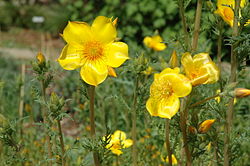| Mentzelia | |
|---|---|
 | |
| Mentzelia lindleyi | |
| Scientific classification | |
| Kingdom: | Plantae |
| Clade: | Tracheophytes |
| Clade: | Angiosperms |
| Clade: | Eudicots |
| Clade: | Asterids |
| Order: | Cornales |
| Family: | Loasaceae |
| Genus: | Mentzelia L. |
| Species | |
Some 60-70, see text | |
| Synonyms | |
| |
Mentzelia is a genus of about 100 species of flowering plants in the family Loasaceae, native to the Americas. The genus comprises annual, biennial, and perennial herbaceous plants and a few shrubs.
They are commonly called blazing stars or stickleafs; other names include evening stars and moonflowers.
